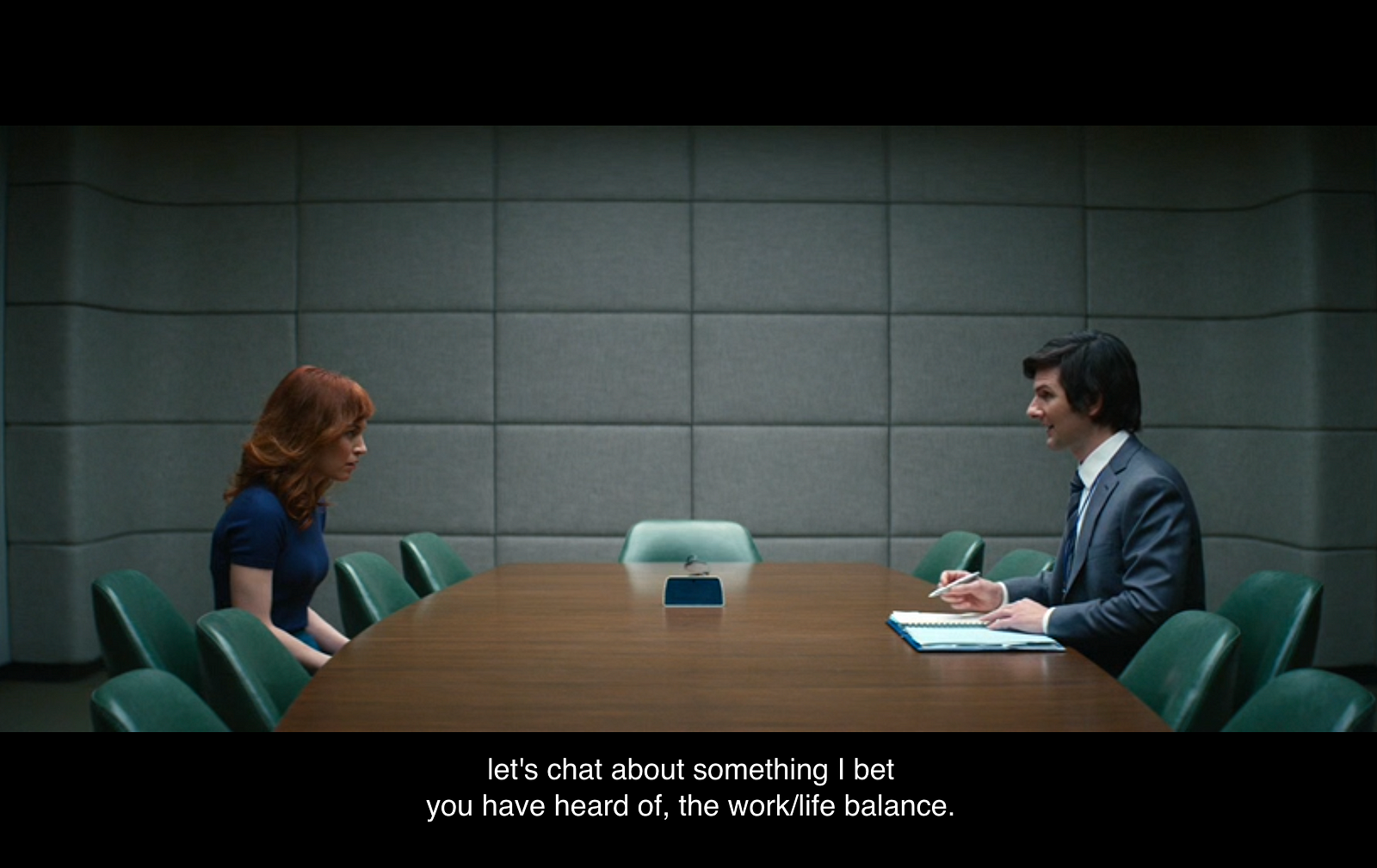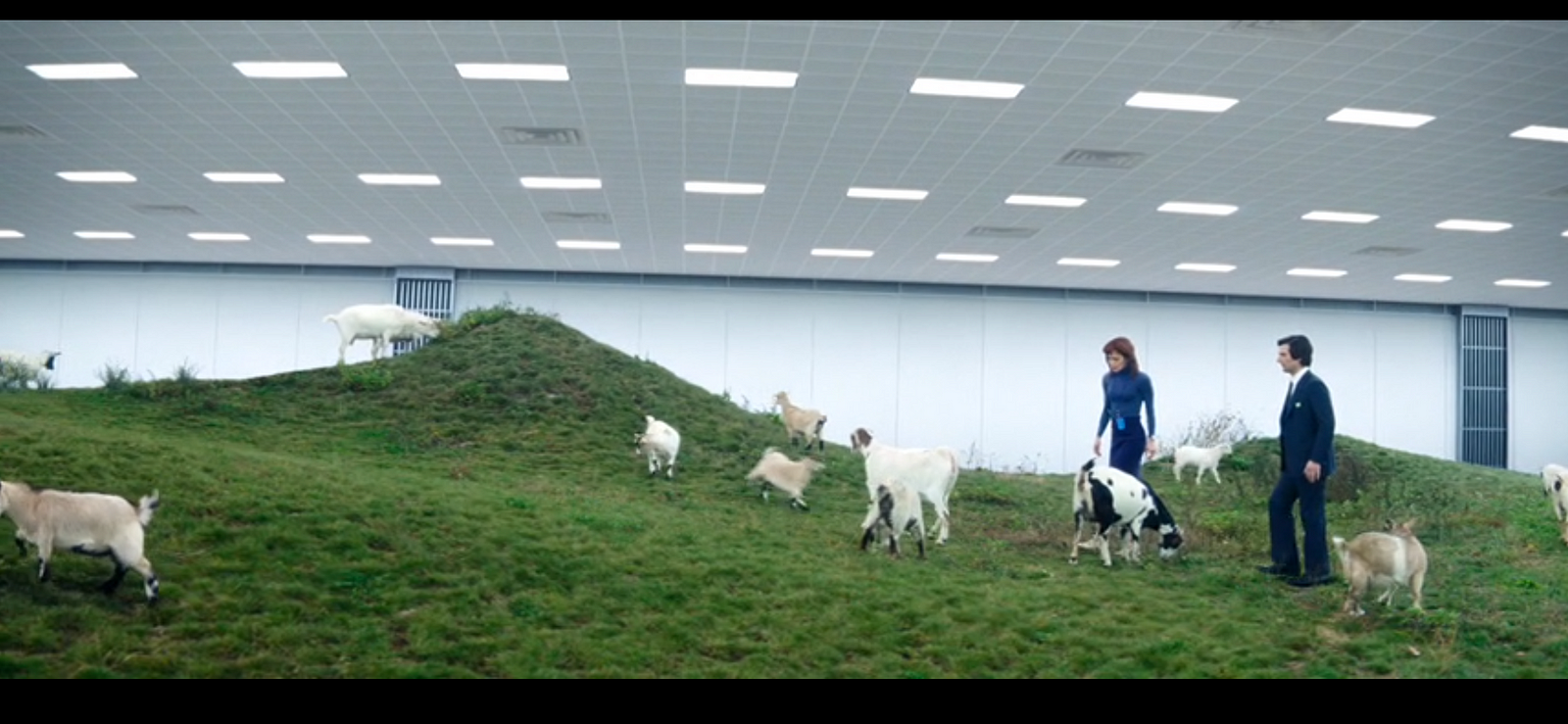“Severance” & the Post-Human Workplace
Light spoilers ahead… it’s mostly early series stuff, nothing about season finales.
The phenomenon that is Ben Stiller and Dan Erickson’s thriller series “Severance” took a while to land in my consciousness, much to my chagrin. When I learned that the entire story rests on the premise that a new technology — invented by the fictional Lumon corporation — can sever a person’s “work” persona from their “life” persona, I couldn’t believe I missed a sci-fi story that so perfectly ridicules my own life’s work.
I have a passion for creating experiences that help people live and work better. To me, that means integrating, not severing, these two aspects of our identities. Amidst a loneliness epidemic and the rise of what I recently heard referred to as the “non-human workforce ” (i.e. AI), I focus on designing for connection — our most basic of human needs.
Due to the fundamental importance of sociality to our survival and lineage, evolution has served up a few basic catalysts for human connection, namely: food, conversation and play. These are the top three experiential elements that I use to spark connection when designing workplace experiences. It was as if the writers for “Severance” knew that it was this exact formula that needed to be broken to paint their dystopian masterpiece. In the first two episodes alone, each one of these connection catalysts is served up like a sacrificial lamb, signaling the post-human vibes that the series brings to life.
FOOD
Think about the idiom “food is life.” While it’s true that we would literally die without eating, the “is-ness” of the phrase connotes a grander meaning. Food is everything — from the first bond between a newborn and mother to the way we express and consume culture; from an act of love to a rarefied art form; from fuel for an all-nighter to a lifetime of breaking bread with family and friends. I like to say that sharing a meal is the original social networking because meals are so commonly and obviously looked-to when forming or strengthening bonds. Building trust over a shared meal makes sense biologically too — when we eat we are at our most vulnerable, with the “rest and digest” nervous system activated. It’s literally impossible to have your guard up while you’re eating.
One of the first things that happens in the pilot episode of “Severance” is Mark’s sister whisking him away to a “foodless dinner.” Mark asks plainly, “So if there’s no dinner, how is it dinner?” What it is instead is a bunch of people acting out the form of dinner, without the experience itself. The conversation is empty and Mark leaves hungry. When one guest says, “What a lot of people overlook, I think, is that life is not food,” Mark seems to be the only one who clearly disagrees. He knows that, in fact, food is life, and yet he is also the only one at this foodless dinner who has submitted to the severance procedure. It’s as if he knows what it means to be human at such a basic level, he also understands that disconnecting from this essence is his only ticket to avoid the also very human experience of feeling pain. Because as we soon learn, spending less time grieving the loss of his beloved late wife is the reason Mark agrees to be severed in the first place.
The fact that the show’s first take down of the most essential connection catalyst (food sharing) occurs in the “real” (non-severed) world points to how the actions we take inside large corporations influence the rest of the world. Perhaps it is because Lumon so normalized the idea of a severed humanity that the concept seeped into the subconsciousness of the very people who purportedly protest it — as evidenced by their robbing themselves of the fundamental human connection that occurs over a shared meal. But Mark’s mind’s rebellion against the blasphemous notion that “life is not food” foreshadows the role both versions of himself will eventually take in raging against the machine that seeks to annihilate his humanity.
CONVERSATION
What can be more human than engaging in a genuine, two-way conversation? It’s this very capacity that Dr. Sherry Turkle of MIT has been cautioning the world to preserve (in the name of empathy) as technology increasingly captures and shortens human connective attention. Since phones and the social media apps they enable entered our pockets and bedrooms in the late aughts, they have both expanded and eroded human connection. Dylan Marron spun up a whole podcast dedicated to this phenomenon called “Conversations with People who Hate Me.” He would bring two people together who had gotten into a conflict online and expertly facilitate a conversation between them about it, which ended in deeper understanding almost every time. He ended each episode with the tagline “Remember, there’s a human on the other side of the screen.”
In her 2012 article The Flight from Conversation Dr. Turkle wrote of a “16-year-old boy who relies on texting for almost everything” and who said “almost wistfully, ‘someday, someday, but certainly not now, I’d like to learn how to have a conversation.’” Now, in the year 2025, that boy has grown to be a 28 year old man, likely in the workforce. Have he and his peers learned how to have the kinds of conversations you need to thrive at work and in life?
In his severed form, Mark S. is responsible for having the first conversation Helly R., a newly severed employee, will experience. Having never done this before, he attempts to follow the exact script in the handbook, which only infuriates Helly R. His delivery of the script in stilted patter, reminiscent of the most cheesy and boring of canned telemarketers, is uncomfortable to witness. And so ensues a mind-numbing back and forth as he tries to get Helly R. to answer the question “Who are you?” in a variety of ways. And isn’t all human conversation a way to convey who we really are?
But in this case, the point is to convey that the question is unanswerable because this is a post-human world. When Helly R. fails to answer, she is deemed as having received a “perfect score” on this conversation. The last piece of the script Mark S. reads before he breaks character is “I understand you’re confused about the severance procedure. Before we hop on that, let’s chat about something I bet you have heard of, the work/life balance. To start, imagine yourself as a seesaw.” At this point, he can no longer tolerate the absurdity of the script, and he puts it aside, summoning innate human empathy that the severance procedure has apparently not eliminated. He ends up sharing his own story of going through this same conversation on his first day at Lumon, which leads to him forming a genuine bond with Helly.
PLAY
Play is evolution’s mechanism for allowing humans to experiment with failure. Whether for physical or psychological safety, play allows us to be vulnerable and learn, in the “what doesn’t kill you makes you stronger” kind of way. When it comes to social connection, play can provide a safe forum for physical touch, practicing competition / collaboration, or even broaching otherwise taboo topics. Play is not just for kids, nor is it best left out of the workplace. Maybe you’re one of those people who loathes what can feel like shallow ice-breakers or “forced fun.” Hear me out on this one. I’ve been there myself, cringing at having to spend my precious time and energy on “fun” that didn’t suit me. I actually have a pretty hard time finding my way to “play” on most days — just ask my kids. Yet research has shown that when teams at work play games together, their productivity can be boosted by 20%. The researchers hypothesized that this was due to the game providing an opportunity to practice collaboration towards a common goal — while also blowing off steam. I’ve experienced firsthand the power of genuine play (the fun kind) to connect coworkers — as both a participant and leader. In fact, playful experiences to enhance connection between colleagues is what my own team spends a lot of our time designing these days, but I digress.
With Helly R. finally on board, she must be oriented to the newly formed team. What better moment to build rapport through the safe experience of a game? The team’s manager, Mr. Milchik, assembles the workers into a circle of chairs and introduces a ball-toss game where each person who catches the ball must tell the group something about themselves. A hallmark of corporate cliches, the scene even includes a brief reminder to one of the team members that “there will be no trust falls” this time.
Yet on the severed floor, disclosing a bit of personal information in service of the game is, of course, impossible, since each severed employee lacks personal identity and agency to varying degrees. All Mark could come up with is “I’m Mark. Been with Lumon about two years, and I absolutely love this game.” There is an unspoken vibe over the scene that if Mark didn’t, in fact “love this game,” he would not be welcome to say so. Literally speechless, Helly R. defers to Mr. Milchik who fills in words on her behalf: “she’s thirty years old, she’s allergic to almonds and has weak enamel. At 5′6″, she’s the fourth tallest person in your office, and her hair is what we call shoulder-length. And seeing her here with you all, I’d say she most definitely has a family.” Constrained to surface-level facts, the game is over quickly and the sense is that the employees are no closer to being a team than they were at the outset. A more perfect encapsulation of “forced fun” I have never witnessed.
REDEMPTION
Did the writers of Severance KNOW about these three basic connection catalysts and so take them down explicitly within the first two episodes? Or are Food, Conversation and Play so essential to human connection that they emerged naturally as primary thematic elements through the writers’ own creative process? In either case, seeing the world of workplace experience that is my profession so expertly inverted was both a horror and a delight — the hallmark of any great sci-fi thriller.
I’m looking forward to an eventual season 3, when I imagine redemption will come in the form of Helly, Mark, Mr. Milchik and the whole Macro Data Refinement crew sinking their teeth into a delicious meal at a restaurant, engaging in scintillating conversation… and maybe even enjoying a team game night. What I wouldn’t give to have the honor of designing the first truly meaningful workplace experiences for each human from the severed floor.






